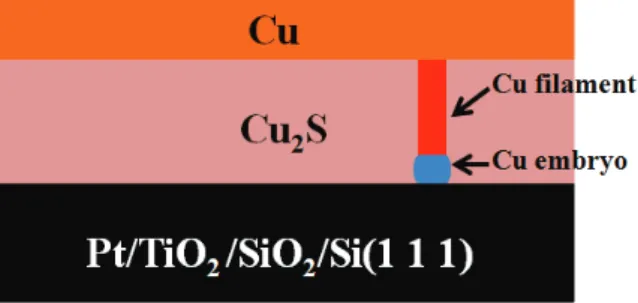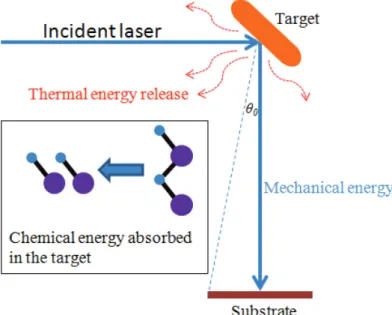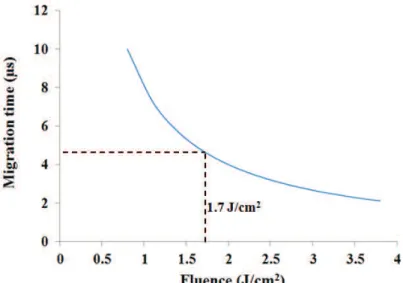To link to this article :
URL : http://www.ijaet.org/media/5I37-IJAET1001126-v10-iss1-pp46-51.pdf
O
pen
A
rchive
T
OULOUSE
A
rchive
O
uverte (
OATAO
)
OATAO is an open access repository that collects the work of Toulouse researchers and makes it freely available over the web where possible.
This is an author-deposited version published in : http://oatao.univ-toulouse.fr/ Eprints ID : 17623
To cite this version : Myerlas, Robert Key Parameters of Pulsed
Laser Deposition for Solid Electrolyte Thin Film Growth. (2017)
International Journal of Advances in Engineering & Technology, vol. 10 (n° 1). pp. 46-51. ISSN 2231-1963
Any correspondence concerning this service should be sent to the repository administrator: staff-oatao@listes-diff.inp-toulouse.fr
K
EY
P
ARAMETERS OF
P
ULSED
L
ASER
D
EPOSITION FOR
S
OLID
E
LECTROLYTE
T
HIN
F
ILM
G
ROWTH
Robert Myerlas
710 S. Atlantic St., Dillon, MT 59725, USA
A
BSTRACTThe pulsed laser deposition (PLD) technique has been a common method to grow thin films such as solid electrolyte (SE). The effects of substrate temperature and laser fluence on the thin film properties and the device performance are analyzed. For the first time, a quantitative analytical model dealing with the energy conversion in the process when laser hits the target is presented, which provides a solution that is crucial in correlating the formation of high quality and uniform thin films to the experimental design. The migration speed of the ablated particles, which determines the quality of the deposited films, is found to be directly related with the laser fluence. Specifically, a threshold fluence is required to generate high purity single form thin film. This model provides the opportunities to improve experimental design and quality control.
K
EYWORDS:
solid electrolyte, thin films, memory device, pulsed laser deposition (PLD)I. I
NTRODUCTIONNowadays the rapidly increasing demands in electronic devices have promoted the design and development of specialty materials in a variety of forms and structures [1-6]. For example, the substrate and thin film materials are experiencing an evident trend into biodegradable and environmental friendly paradigms, such as chitosan and cellulose nanomaterials [7]. These biodegradable have found extensive practical functionalities in a variety of areas, e.g., medical care [8], gas separation [9], and construction materials [10-13], while their use in electronics is still in a preliminary phase. Satisfying the requirements for sustainability, the performance of the devices is achieved via a few approaches, one of which is to fine-tune the performance of the individual components as well as the devices via employing nanomaterials with extremely small scale, inspired by the concept of controlling materials properties from the most fundamental level [14, 15]. Thin film solid electrolyte (SE) composed of nanoparticles is a class of materials which have considerably high ionic conductivity and variable electron conductivity. SE thin films have broad applications, such as solid state batteries [16], sensors [17], fuel cells [18], and memory cells [19]. The major advantages of SE thin films are the large resistive ratio between high and low resistivity states and the high ionic conductivity. When making memory cells, the two states are assigned as “1” and “0” in a memory device. The resistivity of the two states should be significantly different (by orders of magnitude) to design a robust memory. The ionic conductivity determines the efficiency of work of the memory device. An SE memory device consists of a large amount of memory cells. Figure 1 shows a typical structure of the cell. In this example, Pt/TiO2/SiO2/Si(1 1 1) substrate is covered with a SiO2 (a few
hundred nm thick) layer using plasma-enhanced chemical vapor deposition. Afterwards focused ion beam was performed to drill a hole to expose the bottom electrode. Then deposition of Cu2S films is
completed with pulsed laser deposition (PLD). The final step is to deposit Ag electrode using a DC sputtering technique.
Fig. 1. A typical structure of memory device cell
Figure 2 shows a working principle of an SE memory cell. When applying a positive voltage across this structure (Pt/TiO2/SiO2/Si(111) substrate as the anode while Cu as the cathode), due to the redox
reaction, Cu2+ will be deposited onto the substrate as Cu atoms. Then the Cu atoms form a filament
across this structure, from bottom to top, depicted as the red filament connecting the two electrodes in the figure. Because the conductivity of SE is quite low, before the Cu filament reaches the cathode, this memory cell is at the high-resistive state, i.e., “off” state for a memory. When the Cu filament touches the top Cu electrode, as a result of the high conductivity of Cu, the cell suddenly changes into a low-resistive state, namely the “on” state. On the other hand, when applying a negative voltage across it, the filament is resolved into the SE immediately, and hence makes the cell turn into “off” state again. As a result, one can simply control the resistivity of the memory cell by changing the direction of voltage on it. After assigning the “off” state as “1”, “on” state as “0”, a memory cell is established.
Fig. 2. Cu atoms grow from the bottom to top as a filament when applying a positive voltage
The property of solid electrolyte is the most critical parameter in determining the performance of the cell as well as the memory device. In this paper, PLD, the state-of-the-art technique to grow SE thin films is evaluated in depth. A major advantage of PLD is the capability to prepare stoichiometric multicomponent films [20], which largely determines the robustness and reliability of a memory device. In addition, PLD is able to deposit many different types of materials, regardless of the physical and chemical properties. Although the most intriguing advantage of PLD is to maintain the stoichiometric composition. The experimental parameters, however, demand a careful design to generate exact targeted stoichiometry (as the source material) for the thin films. In this present paper, two significant parameters, substrate temperature and laser fluence for PLD are discussed; then a quantitative analytical model is proposed to correlate the laser fluence with particle migration speed (time) to present the importance in creating high quality stoichiometric thin films.
II.
S
UBSTRATET
EMPERATUREThe temperature during the deposition is an important parameter. It was reported [21] that a proper temperature is significant for a pure composition of RbAg4I5 thin films. At room temperature, the
main XRD peaks represent RbAg4I5, with some impurity of AgI. The crystallization with RbAg4I5
phase happens when the substrate temperature reaches 80 °C. While the films are deposited at 120°C, some diffraction peaks from AgI with a large intensity appear. It shows that the range of the substrate temperature for depositing the pure RbAg4I5 films is not very wide (around 80 °C).
At room temperature, the sizes of crystal particles are between 1.2 μm and 0.7 μm and the surface is rough. As the temperature reaches 80 Ԩ, the surface becomes obviously uniform and flat, and the average size of the particles decreases to 0.7 μm. For films deposited at 120 Ԩ, the surface of the films is even flatter. The change in the surface morphology with the substrate temperature may be resulted from the large mobility of ions. For SE, ionic mobility is high at first. With increased temperature, the ions are excited with more kinetic energy and more mobile, and hence the surface is less coarse. In this report, with increased substrate temperature, comes pure RbAg4I5 films at 80 Ԩ,
however when temperature reaches 120 Ԩ, the undesired AgI phase is formed again. As a result, the proper temperature frame targeting RbAg4I5 is a narrow window around 80 ԨǤ In addition, when
temperature increases, the surface becomes smoother, which may be due to the ionic mobility. This is also a significant parameter for memory device, because with large ionic mobility in solid electrolyte, the metal filament can grow and resolve very fast, and hence shorten the reaction time of the device.
III.
L
ASERF
LUENCED
EPENDENCELight of intensity is also an important parameter of PLD. It denotes how much energy the laser hits the target in a designated area and time (J/(m2 s)). A similar parameter referred as laser fluence, which
has a different unit of J/m2, indicating the energy focused on the area within each pulse.
It was reported [21] that larger intensity tends to form the crystallization of a desired form of RbAg4I5,
and increase the resistance of the “off” state, and lower intensity results in the undesired AgI phase in the films and reduces the resistance of the “off” state. When the energy fluence is less than 1.7 J cm−2,
there are some peaks of impurity phase from AgI, such as AgI(1 0 1). When the fluence surpasses 1.7 J cm−2 pure RbAg
4I5 films are obtained. This denotes a higher fluence favors the formation of the pure
RbAg4I5 phase. The possible reason is that the higher fluence provides materials ejected from the
target with sufficient kinetic energy, which shortens the migration of species to the substrate and minimize the possibility of dissociation and form changes. Because of the significance of the migration speed resulted determined by the laser influence, here an analytical approach is provided to evaluate the relationship between fluence and kinetic energy of particles. Given that the beam energy is converted into thermal, chemical, and mechanical energy [20] (shown in Fig. 3), resulting electronic excitation of target atoms, ablation and some other processes, the following model is presented
ܰ௨௦݂ݏ ൌ ܧ௧ ܧ ܰ௧ቀଵଶ݉ݒଶቁ (1)
In this model, Npulse is the total number of pulse, s the crosssection area of the laser, m the mass of a
single particle, Ethermal proportional to f, while Echemical proportional to Nparticle - the total number of
particles ablated and deboned from the target, which relates with the number of particles deposited onto the substrate, i.e., N’particle:
ேᇱೌೝ ேೌೝ ൌ ሺୡ୭ୱ ఏሻబഇబ ήଶగሺή୲ୟ୬ ఏሻ ௗఏ ഏȀమሺୡ୭ୱ ఏሻήଶగሺή୲ୟ୬ ఏሻ ௗఏ బ ؠ ݇ଵ (2)
Where θ0 is the angle that covers the entire area of the deposited thin film (see Fig. 3), and 8<n<12
[20]. N’particle can be readily estimated as:
ܰԢ௧ ൌௌ௧ (3)
Where S is the deposited area, t the thickness, V the volume of a single particle, where t and V can be found out from the SEM images. As a summary, Equation (1) can be rewritten as the following formula relating fluence and migration speed:
Fig. 3. Energy conversion of incident laser into different forms
In the work by Yang et al. [21], f=1.7 J/cm2, the thin film deposited at 80 °C has particles of average
size of about 0.7 μm. While it may be challenging to the measure the density of single particles, one can assume that the density of particle is about that of the target, given that the target is finally pressed into a dense pellet under high pressure. In the computation the density of a single particle is assumed as 10 g/cm3. In this work [21], the thickness of film is shown as 900 nm. With the area of total thin
film area, and average size of particles, one can obtain the total number of particles in the thin film with the known size of a single particle. The last step is to calculate the number of particles each pulse deposits on the substrate with the total deposition time, repetition rate, and the time of each laser pulse. With Equation (4), the relationship between laser fluence and particle migration speed is given in Fig. 4.
Fig. 4. Relationship between laser fluence and particle migration speed
Based on the results, the migration speed is directly related with the fluence value. When the fluence is 1.7 J/cm2, the migration speed is approximately 1100 m/s, which is believed a minimum value that
is needed to form a pure phase of the desired form and phase. It is worth noting that the threshold time corresponding to the minimum migration speed is about 4.7 μs, as shown in Fig. 5. This time duration is very important concerning the form change, for example, from RbAg4I5 to AgI. It has significant
knowledge of the threshold of migration time, one can enhance the understanding of form and/or phase change of the fast-evolving kinetics during thin film formation.
Fig. 5. Relationship between laser fluence and particle migration time
IV.
F
UTURE WORKThis work has provided a quantitative solution correlating the substrate temperature and laser fluence with the thin film quality. Along with the novelty of this discussion, there has been very limited amount of work presenting experimental data that would help to impove this model. In the future, two approaches should be directed: (1) the purity and stoichiometric measurements of the resultant thin films produced at different conditions, especially around the threshold migration speed; (2) different common SE systems, e.g., RbAg4I5, Cu2S, and ZrO2-Y2O3, should be investigated to build a universal
model that may be validated with different properties at the molecular level.
V. C
ONCLUSIONSPulsed laser deposition (PLD) shows excellent capability of growing thin films such as solid electrolyte, which shows huge potential in non-volatile memory devices. Laser fluence and substrate temperature are two critical parameters during the deposition process, influencing the purity and stoichiometry of the resulting films. A reasonable fluence value is needed to excite a particle migration speed to ensure the integrity of the targeted materials. This work examined the two parameters and established a universal analytical model that relates the migration speed (time) and laser fluence. It shows that the migration speed can be quantitatively determined and the minimum speed for different material systems can be designated as such. This approach will be useful in process design and quality control, as well as theoretical analysis of thin film deposition via PLD when the thin film composition for a uniform stoichiometry is a critical requirement. In addition, the threshold migration time is characteristic of the time needed for a phase/form change, which helps enhance the understanding in the molecular dynamics in the fast-evolving process of PLD.
R
EFERENCES[1] Meredith P, Bettinger CJ, Irimia-Vladu M, Mostert AB, Schwenn PE. Electronic and optoelectronic materials and devices inspired by nature. Reports on Progress in Physics. 2013;76(3):36.
[2] Lipomi DJ, Bao Z. Stretchable, elastic materials and devices for solar energy conversion. Energy & Environmental Science. 2011;4(9):15.
[3] Cai W, Huang L, Wen W. 2.4GHZ Class AB Power Amplifier for Wireless Medical Sensor Network. International Journal of Enhanced Research in Science, Technology & Engineering. 2016;5(4):5.
[4] Cai W, Huang L, Wu N. Class E Power Amplifier for Wireless Medical Sensor Network. International Journal of Enhanced Research in Science, Technology & Engineering. 2016;5(4):6.
[5] Cai W, Wu B, Wu N. 2.4 GHz Class F Power Amplifier for Healthcare Application. International Journal of Computer Science and Information Technologies. 2016;7(3):5.
[6] Cao Y. Nano-modification for high performance cement composites with cellulose nanocrystals and carbon nanotubes. PhD Dissertation. 2014.
[7] Irimia-Vladu M, Głowacki ED, Voss G, Bauer S, Sariciftci NS. Green and biodegradable electronics. Materials Today. 2012;15(7-8):7.
[8] Rees A, Powell LC, Chinga-Carrasco G, Gethin DT, Syverud K, Hill KE, et al. 3D Bioprinting of Carboxymethylated-Periodate Oxidized Nanocellulose Constructs for Wound Dressing Applications. BioMed Research International. 2015(925757):7.
[9] Matsumoto M, Kitaoka T. Ultraselective Gas Separation by Nanoporous Metal−Organic Frameworks Embedded in Gas-Barrier Nanocellulose Films. Advanced Materials. 2016;28(9):5.
[10] Cao Y, Zavattieri P, Youngblood J, Moon R, Weiss J. The relationship between cellulose nanocrystal dispersion and strength. Construction and Building Materials. 2016;119:9.
[11] Cao Y, Zavaterri P, Youngblood J, Moon R, Weiss J. The influence of cellulose nanocrystal additions on the performance of cement paste. Cement and Concrete Composites. 2015;56:11.
[12] Cao Y, Tian N, Bahr D, Zavattieri PD, Youngblood J, Moon RJ, et al. The influence of cellulose nanocrystals on the microstructure of cement paste. Cement and Concrete Composites. 2016;76:10.
[13] Cao Y, Weiss J, Youngblood J, Moon R, Zavattieri P. Performance-enhanced cementitious materials by cellulose nanocrystal additions. Production and Applications of Cellulose Nanomaterials. 2013:2.
[14] Sobolev K, Lin Z, Cao Y, Sun H, Flores-Vivian I, Rushing T, et al. The influence of mechanical activation by vibro-milling on the early-age hydration and strength development of cement. Cement and Concrete Composites. 2016;71:10.
[15] Sun H, Hohl B, Cao Y, Handwerker C, Rushing TS, Cummins TK, et al. Jet mill grinding of portland cement, limestone, and fly ash: Impact on particle size, hydration rate, and strength. Cement and Concrete Composites. 2013;44:9.
[16] Tarascon J-M, Armand M. Issues and challenges facing rechargeable lithium batteries. Nature. 2001;414:9. [17] Maskell WC. Progress in the development of zirconia gas sensors. Solid State Ionics. 2000;134(1-2):8. [18] Haile SM. Fuel cell materials and components. Acta Materialia. 2003;51(19):20.
[19] Sakamoto T, Sunamura H, Kawaura H, Hasegawa T, Nakayama T, Aono M. Nanometer-scale switches using copper sulfide. Applied Physics Letters. 2003;82(18).
[20] Ohring M. Materials Science of Thin Films. 2nd ed2001.
[21] Yang B, Liang XF, Guo HX, Yin KB, Yin J, Liu ZG. Characterization of RbAg4I5 films prepared by pulsed laser deposition. Journal of Physics D: Applied Physics. 2008;41(11):5.
A
UTHORSB
IOGRAPHYRobert Myerlas was born in Miami, USA, in 1993. He received the Bachelor in Science degree from the Florida
Institute of Technology, Melbourne Florida, in 2015. He is currently pursuing the Master’s degree with the Department of Education, University of Montana Western, Dillon Montana. His research interests include electrical engineering education, thin film characterization, and high performance flexible electronics.


